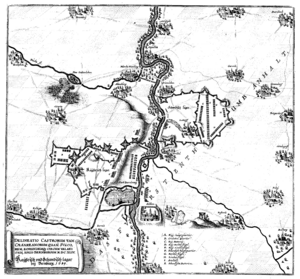Battle of Jüterbog facts for kids
Quick facts for kids Battle of Jüterbog |
|||||||
|---|---|---|---|---|---|---|---|
| Part of the Thirty Years' War | |||||||
 Swedish and Imperial encampments prior to the battle |
|||||||
|
|||||||
| Belligerents | |||||||
| Commanders and leaders | |||||||
| Strength | |||||||
| 18,000 | 4,000 cavalry | ||||||
| Casualties and losses | |||||||
| 400 killed or wounded | 1,000 killed or wounded, 1,600 men and 3,500 horses captured | ||||||
The Battle of Jüterbog was an important fight during the Thirty Years' War. It happened on December 3, 1644, near the town of Jüterbog in Germany. In this battle, the Swedish army fought against the forces of the Holy Roman Empire. The Swedes won a big victory. This battle was special because the Imperial army's cavalry (soldiers on horseback) tried to escape from a Swedish blockade but were mostly defeated.
Background to the Battle
The Swedish Army's Journey
In September 1643, a Swedish general named Lennart Torstenson led his army into Jutland. This was part of a conflict known as the Torstenson War. While the Swedes were busy there, an Imperial army started moving north. This Imperial army was led by Count Matthias Gallas. Their goal was to trap the Swedish army in Jutland and defeat them.
Imperial Plans and Swedish Moves
The Emperor had promised help to Denmark-Norway. He believed the Swedish forces were tired and easy to beat. However, General Torstenson saw Gallas's army as a threat. He worried about important Swedish strongholds on the German Baltic coast. So, Torstenson quickly turned his army around. He headed south to face the Imperial forces.
Gallas's Traps and Swedish Skill
Count Gallas tried to trap the Swedes. He built strong defenses near the Eider River in Holstein. But Torstenson's army was too clever. They outsmarted Gallas by taking over some Imperial positions. This put Gallas's army in danger from behind. It also threatened Imperial areas further south.
The Retreat and Siege
The Imperial army then began to move south. Throughout the summer of 1644, Torstenson's forces chased them. By late September, the Swedes had caught up again. Gallas ordered his troops to build strong defenses. He hoped for more soldiers to arrive.
The Imperial army stopped at Bernburg, south of Magdeburg. Soon, the Swedish army surrounded them. They cut off all supplies. Gallas's men quickly ran out of food, especially bread. Many soldiers became sick or died from hunger.
Escape Attempt from Magdeburg
With so many people and animals dying, Gallas had to make a tough choice. He left behind many sick soldiers, most of his cannons, and all their baggage. He moved his remaining troops into Magdeburg, a strong city held by his allies, the Saxons. But the Swedes followed. They surrounded Magdeburg too, cutting off supplies once more. One night, the Imperial cavalry tried to break out of the city.
The Battle of Jüterbog
The Imperial Cavalry is Caught
The rear part of the Imperial cavalry was led by Adrian von Enkevort. As they tried to escape, they were caught near the town of Jüterbog. The Swedish army attacked them fiercely. Most of Enkevort's cavalry was wiped out. Enkevort himself was captured by the Swedes. The Swedes also took 3,500 horses.
Escape of Other Imperial Troops
The rest of the Imperial cavalry was led by Count Bruay. They barely managed to escape into Lusatia. Among those who got away were important officers like Bassompierre and Raimondo Montecuccoli. They reported the terrible defeat to their leaders.
Aftermath of the Battle
Desperate Times in Magdeburg
It took a while for the Imperial forces still trapped in Magdeburg to break out. Their situation became very desperate. They had to eat cats and dogs to survive. Many soldiers gave up and left the army. Some tried to join the Swedish forces, but the Swedes often refused them. They were too weak from hunger and sickness.
The Final Breakout
In early January 1645, the Imperial forces got a chance to escape. Ice on the Elbe River broke some Swedish bridges. Gallas, who was sick, stayed with the ill soldiers. His officer, Hunolstein, led the remaining 1,400 foot soldiers. They also had a few horsemen and 12 cannons. They marched through Wittenberg to Bohemia. They safely reached Prague in February.
Gallas is Replaced
Out of 12,000 Imperial soldiers that Gallas had in the summer of 1644, only a few thousand returned. This campaign was a huge failure. Because of his mistakes, Gallas was removed from his job as the Imperial commander.
Sources

